This is my ongoing project to assess the performance of various VESA Local Bus cards.
Executive summary
In DOS usage, defined as CPU-originated low-resolution memory writes to Video RAM through VGA registers, there is only a small difference between various VL-BUS cards. Some chip designs are more optimized than others, which translates into slightly higher performance, but in the end almost¹ all cards are within 20% of each other. If splitting hairs, cards with the ARK1000P chip seem to be the most optimized in DOS, where they maintain a small edge over anything else. The author’s opinion is that picture quality and VGA compatibility are more important than performance when it comes to DOS.
In Windows, differences between cards are much more pronounced. Cards vary in the number of GUI acceleration features (and the drivers that use them). As resolution, bit depth and refresh rate increase, the graphics processor must compete for bandwidth with the RAMDAC controller. This is where more advanced memory designs—with faster chips, 64-bit, interleaved 32-bit, or dual-ported VRAM interfaces—show their strength, keeping pixels flowing even at high resolutions where DRAM-based cards struggle.
To declare the winner. Combining DOS/Windows performance and image quality and compatibility together the crown should go to the Diamond Stealth 64 VLB DRAM. This card delivers outstanding Windows performance, solid DOS performance and exceptional VGA compatibility.
¹ Diamond Viper VLB is exception as it is using a very slow VGA chip which is only using 16-bit interface. Another lemon was the Diamond Speed Star Pro SE showed somewhat slower DOS performance compared to other cards.
Contenders
SPEA V7 Mirage (S3 805-P)
The first card in my roundup is SPEA made V7 Mirage based on S3 805 chipset. Launched in February 1993, the Mirage was Spea’s mid-range product line sitting above the entry-level Vega and high-end Mercury.
The S3 805 is one of the most common VL-Bus VGA chips. This V7 Mirage came with 1 MB DRAM of relatively fast 50ns speed. This card showed average performance in DOS, just below the group of top performers. In Windows, the performance was below average though.
SPEA V7 Mirage P64 (S3 864)
The successor of the V7-Mirage is V7 Mirage P64. It is a 64-bit accelerator powered by the S3 Vision 864 chip. Compared to the 805-P chip the Vision 864 has a full 64-bit interface to video RAM which should translate to higher performance, especially at high-resolution true colour modes. The chip is accompanied by 2 MB of DRAM.
In DOS performance is very good. The card earned a nice second spot shared with a group of 8 other cards trailing behind the Bali32 card. In Windows, the performance is above average, but slower than other high-end cards in the test.
Orchid Fahrenheit VA/VLB (S3 805)
The second S3 805 based card in the test is an interesting one. It is a unique combination of a VGA card with a sound card. Since it was designed for “serious business”, don’t expect AdLib compatibility or CD-ROM interfaces, but at least a Sound Blaster compatible DAC is there. In DOS, sharing the same chip the VGA performance is almost identical to the V7 Mirage. In Windows, the card is somewhat slower in the true-colour mode which is not surprising due to the simple 32bit memory DRAM design.
The card comes with 1MB DRAM and has DIP sockets ready for an upgrade to 2MB, however, such an upgrade can only enable 1280×1024/256 colours mode which is only 48 Hz interlaced due to mediocre 80MHz Sierra SC15025 RAMDAC converter.
Diamond Viper VLB B3 (Weitek P9000 + 5286)
The Diamond Viper VLB rev. B3 is a high-end card from 1993. It features not one but two graphics chips. The first one is Weitek P9000, which is a competent Windows accelerator with 2 MB of dual-ported VRAM. As the P9000 is not VGA compatible, the card also contains the Weitek 5286 chip sitting on the ISA bus using its own dedicated 1 MB of DRAM. The idea here is that the 5286 handles VGA modes until you load a GUI driver. Then the much more powerful V9000 chip takes over.
This solution proved to be suboptimal for DOS where the card was easily the slowest in the test. In Windows, the card performs much better, but still not enough to claim the top. It should be noted that I had problems finding stable drivers to even complete Windows 3.1 benchmarks. This was also the only board in my test that couldn’t handle 0 wait state setting on my 41 MHz VLB test system which surely had some impact on performance.
One trick to improve DOS performance is to load a VBE driver. Then VESA compatible apps could use the Weitek P9000 delivering much better performance than when using the mediocre 5286 chip. Note the relatively solid PC Bench score in VESA 101 mode that was obtained by using this workaround. However, this won’t improve the performance of apps that use standard VGA modes.

Diamond Viper VLB E3 (Weitek 9000 + OTI 087X)
The second version of the Diamond Viper VLB is this revision E3 and BIOS version 3.09. One difference to the first one is that it contains a different VGA compatibility chip. Instead of the Weitek 5286, we have OAK OTI 087X. Again we are dealing with a very basic VGA chip in DOS now with only 256kB of Video RAM. This considerably limits resolutions higher than 320×200, so the card doesn’t even meet Super VGA standards.
The other difference is slightly improved RAMDAC. Now we have 135 MHz Brooktree Bt485 instead of 110 MHz part on the older version which results in slightly higher refresh rates at certain resolutions.
DOS performance is just as hopeless as the older revision – or perhaps a hair better. The VGA chip is clearly present just to be able to boot into DOS and hand over to the GUI accelerator as soon as possible. Just as the other Viper, performance in software using VBE 2.0 can be improved by loading the VESA driver which routes graphics operation to the Power P9000 chip.
Windows GUI acceleration is decent considering we are dealing with 1993 hardware – obviously it is no match to newer 64bit chips. Unlike the B3 version, this copy of the card was able to handle 41 MHz bus without extra wait-states and without stability problems. Despite that, it showed an identical if not a tiny bit worse performance than the B3 version.
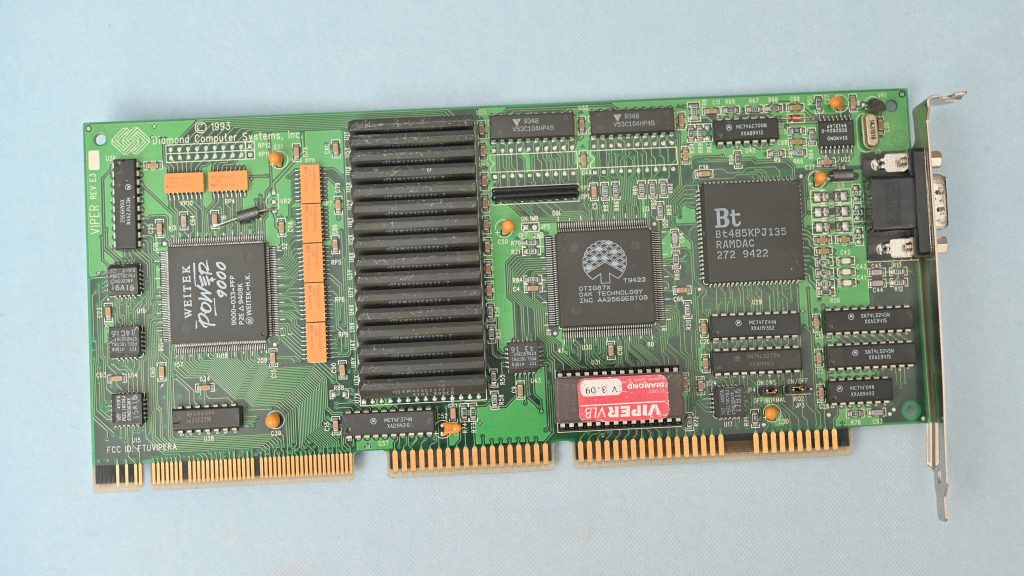
STB Powergraph C33 (WD 90C33-ZZ)
This WDC made card is a reference implementation of the WD90C33-ZZ chip. It is a very competent 32bit accelerator that ticks all boxes on the acceleration list. It can accelerate BitBlt and numerous drawing primitives.
This is a surprise of the test. Initially, it did not perform very well. However, this 1 MB card with very fast 45ns DRAM chips and WD90C33-ZZ chip can be switched to zero waitstate operation using one of several undocumented jumpers located next to the VGA connector. Then the card performs very well and essentially matches the leaders of the test in DOS (except for ARK1000PV cards). In Windows, it delivers average performance.
Cirrus Logic GD5424
The CL-GD5424 on this generic low-end card is a very basic VLB chipset. It is a passive VGA card – it has no GUI acceleration features whatsoever (unless you consider hardware cursor as acceleration). The GD5424 is essentially a scaled-up version of the popular CL-GD5422 for ISA bus with a speed boost thanks to the faster bus. Although the chip offers a full 32-bit memory interface, the performance of GD542x series chips is limited by only a 16-bit host interface.
The CL-GD5424 has been designed for a low cost. It has integrated 80 MHz true-colour RAMDAC and support for a maximum of 1MB DRAM running effectively at 50 MHz speed. The unpopulated DIP sockets on my card are likely a provision for an alternative memory configuration rather than for an upgrade.
Given the lack of acceleration, there is no surprise the card doesn’t particularly excel in Windows. It is two times slower than the accelerated GD5429 sibling and easily the slowest card in the test. Performance in DOS is also below average, but in contact with other cards in this test.

SPEA V7 Vega (CL-GD5428)
The second Cirrus Logic chip comes on this SPEA branded V7 Vega card. Unlike the CL-GD5424, the GD5428 chipset has some acceleration capabilities, including the all-important BitBlt engine which is of older type programmable by I/O access rather than a memory-mapped range.
None of which has any effect whatsoever on DOS performance.
The card’s 32-bit memory interface is clocked at 50 MHz.
In general, the card delivers below-average performance in DOS close to the GD5424 sibling. Sadly this card hasn’t been tested in Windows but I’d expect it to be closer to the GD5429 than GD5424.
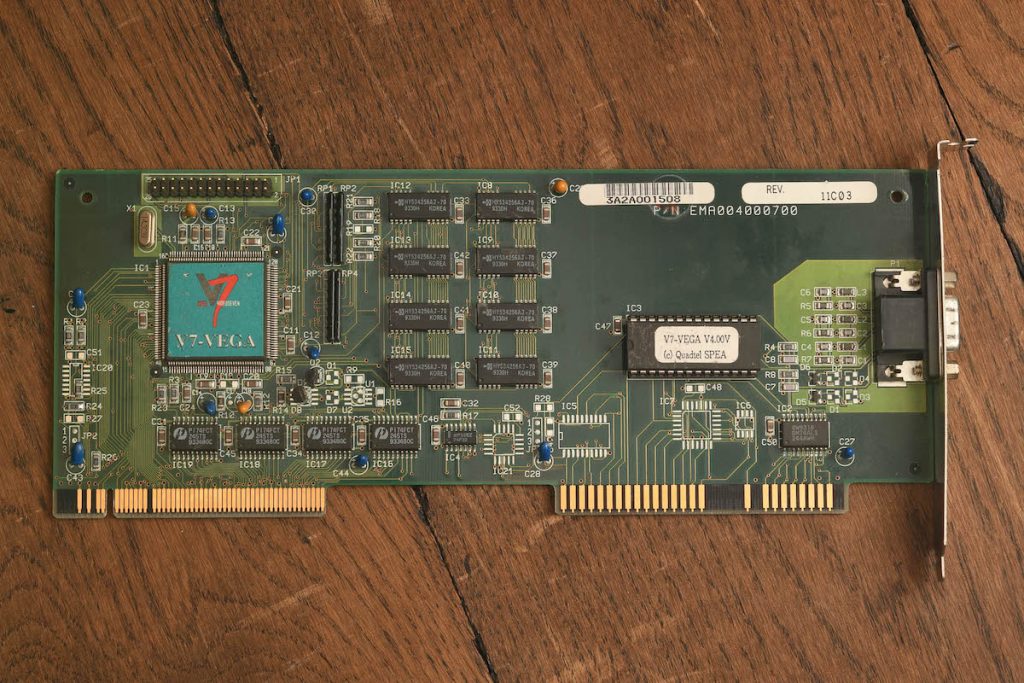
Cirrus Logic GD5429
Another Cirrus Logic card in my roundup uses a somewhat more advanced CL-GD5429 chip. Compared to CL-GD5428 it features the new memory-mapped BitBlt interface which, compared to older register-based design, can potentially speed up certain GUI drawing operations up to four times. The memory interface runs at 60 MHz compared to 50 MHz of older Cirrus Logic chips. On the other hand, just like older chips, the host interface is still 16-bit only.
The card can be upgraded to 2MB DRAM using SOJ sockets, but this upgrade is a bit pointless as given by the basic 86 MHz RAMDAC the only benefit the additional RAM adds is the support of two extra interlaced resolutions. Those hoping for higher resolution than 1024×768 or improved performance will be disappointed.
Performance-wise the card is average in DOS but rather average in Windows, especially when using 16 or 24bit colour modes. But slightly better than cards with older Cirrus Logic chips.
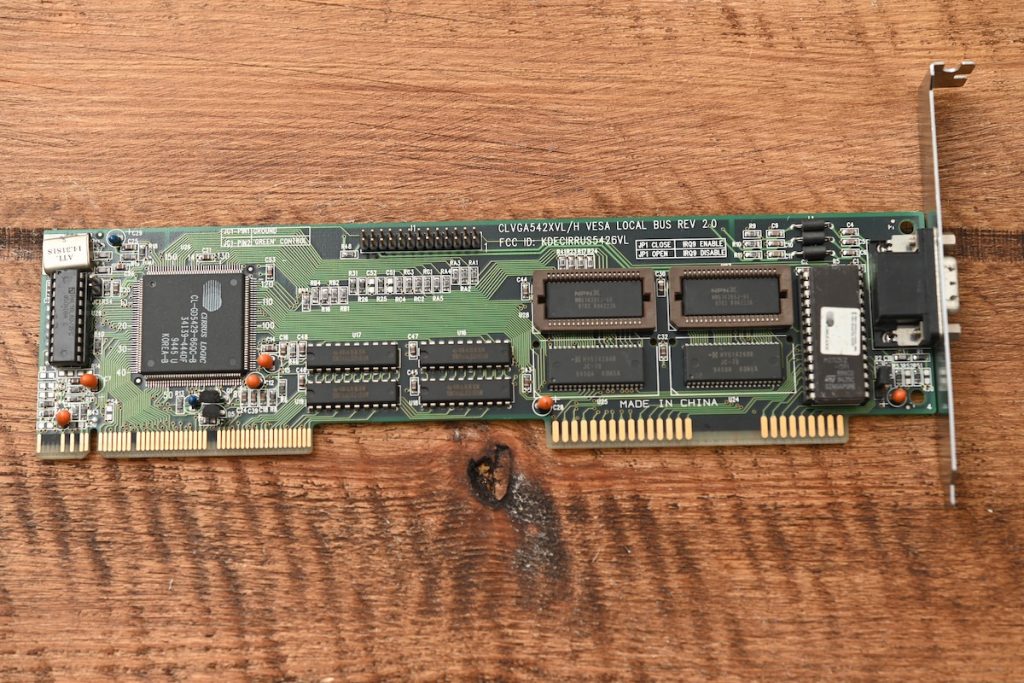
Diamond SpeedStar Pro SE (CL-GD5430)
The final Cirrus Logic based card in my test is this Diamond SpeedStar Pro SE. The CL-GD5430 is the entry model of the Alpine series which is generation up than the GD542x series tested above. It came in 1994 which makes it quite a late chip in VLB standards. The main difference is that the interface is now fully 32-bit on the host side as opposed to the 16bit of the previous chips. GUI acceleration capabilities remain at the CL-GD5429 level which means decent, but not earth-shaking features. It also has the same 86 MHz integrated RAMDAC.
Diamond clocked the chip to basic 50 MHz (the chip supports up to 60 MHz) and supplied 1MB 60-ns DRAM expandable to 2MB. Just as with the previous models the upgrade doesn’t change performance or capabilities in any material way.
I had high hopes for this card. However, it looks like that in the process of host-interface upgrade there was a noticeable regression in DOS performance. The card was 10% slower than even the slowest GD542x which is disappointing. The performance was slightly higher in Windows, however, it only matched the average performance of its CL-GD5429 predecessor.
Diamond Stealth 24 VLB (S3 805)
Yet another S3 805 based card. Despite being equipped with sharp 45ns DRAMs it delivered only below-average performance. Even slower than some other S3 805 cards in the test. Could conservative memory frequency play a role here?
Despite trying I couldn’t reliably run the card in any true colour modes in Windows.
Windows performance is also rather basic. Better than Cirrus Logic card, but well below higher end cards. Performance can be improved by using S3-supplied generic drivers rather than Diamond branded.
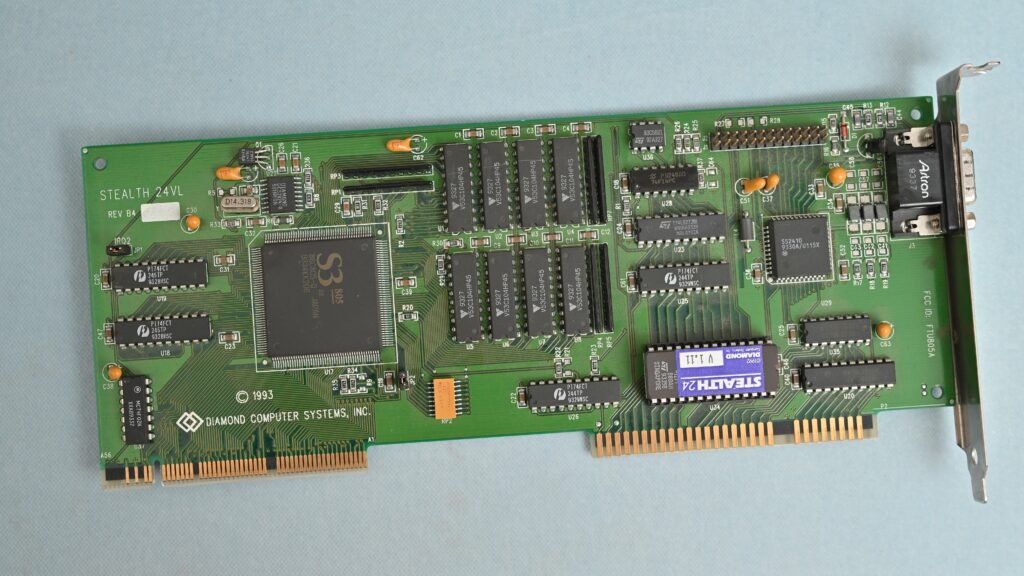
Diamond Stealth 64 VLB DRAM T (S3 Trio64)
Trio64 is one of if not the most advanced VGA controllers that appeared on VL-Bus cards. It is a hi-performance 64bit chip with integrated 135 MHz RAMDAC and 2MB DRAM. As a very modern VL-Bus chipset, it has an amazing feature set with a BitBlt unit with memory-mapped registers, support for the acceleration of all sorts of drawing operations. When configured with 2 MB DRAM, the chipset has a 64bit wide path to video RAM. The RAM chips can use 1-cycle EDO operation increasing the effective bandwidth even further.
The only missing feature is support for external high-speed RAMDAC and dual-ported VRAM chips which is why VL-Bus cards based on higher-end S3 Vision 964/968 chips might offer higher performance when using high-resolutions.
The Trio64 supports up to 4MB of DRAM, but such a combination is rare and the upgrade past 2MB doesn’t give any benefits except for a few interlaced modes.
The card offers perfect DOS compatibility and nice image quality. Arguably, the S3 Trio64 is considered as a reference design for VGA compatibility.
As expected this Diamond branded card showed top performance in Windows and shares also the top spot in DOS. The memory throughput card can be also overclocked by the MCLK utility which can tune to even higher Windows performance (the card has been tested in stock config in this test).
Diamond Stealth 64 VLB VRAM (S3 Vision 964)
Diamond Stealth 64 VRAM was a pinnacle of VL Bus cards and the absolute high-end in 1994. Equipped with dual-ported VRAM chips its full-featured 64bit accelerator doesn’t have to compete with RAMDAC for memory bandwidth. Thus the card was perfect for driving high-resolution screens at high refresh rates. But even at normal resolutions and in VGA modes, the card is still very fast thanks to the traditionally decent S3 VGA controller implementation.
The card won the Windows test just ahead of the newer DRAM-based Stealth 64 card. In DOS the performance was also very in the main group of fastest cards (just shy of Bali32).
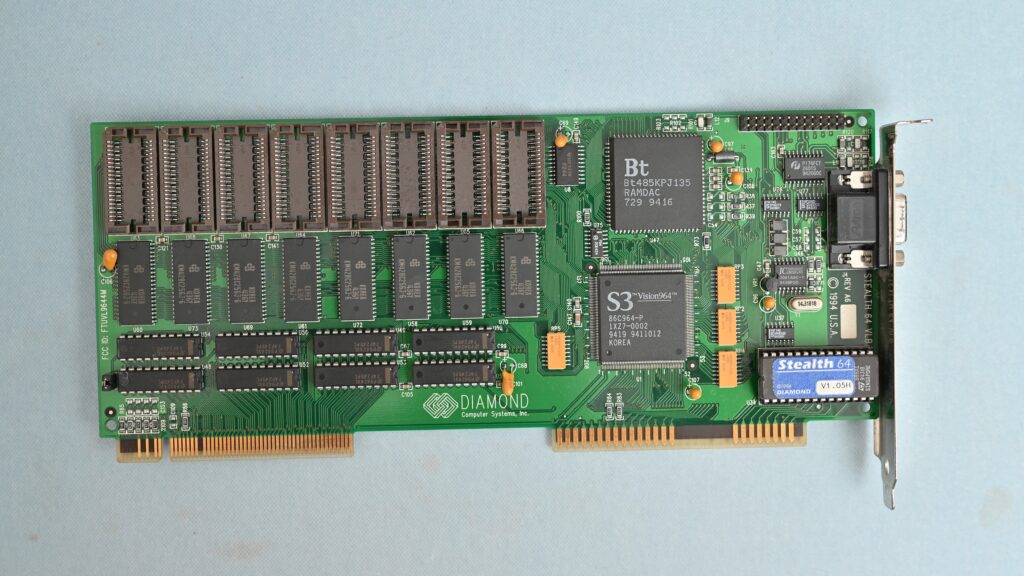
Jaton VL 4l (S3 805i-P)
One of very few cards with late revision of S3 805, the -i variant of the chip. The chip is visibly smaller than the old 805 or 805-p variants. Similarly to the Tseng ET4000 w32i/p chip, the 805-i is using memory interleaving tricks to improve memory bandwidth. However, unlike Tseng based cards the feature seems to be no impact on performance when the card has 1 MB or 2 MB RAM. However, bonus of memory upgrade is that the card can reach 1280×1024 resolution in 256 colours at non-interlaced refresh rate. This is something that couldn’t be taken for granted in its days.
Performance is slightly better than the other S3 805 cards in the test.
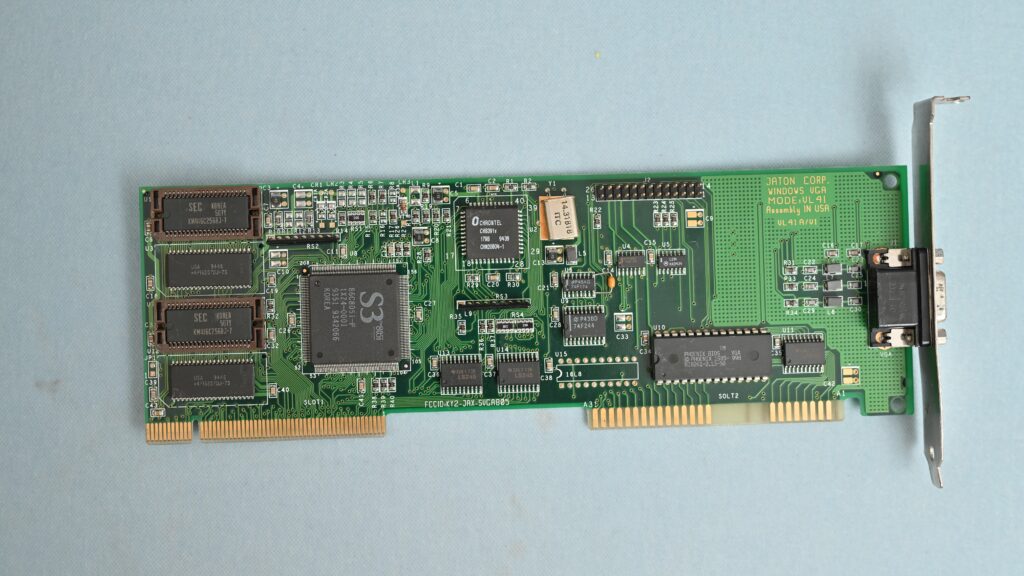
Hercules Dynamite 2MB DRAM (Tseng ET4000 w32/p)
My personal favourite is this attractive Hercules Dynamite with Tseng ET4000 w32p chipset and very fast 45ns DRAM chips. The ET4000 w32p is a 32-bit chipset that can support up to 4MB of DRAM. However, in its most common configuration, it is used with 2MB DRAM that allows for bank-interleaving delivering 1.7x memory write bandwidth compared to the traditional 32bit interface. Thus the card should be able to compete favourably with cards using true 64bit memory interfaces.
The ET4000 in its w32p variant offers a comprehensive GUI acceleration feature set. Including a capable BitBLT unit, drawing functions, colour expansion and more.
The card showed the top performance in DOS and was very fast in Windows too – just a tad slower than the more modern Diamond Stealth 64 card.
Video Magic (Tseng ET4000/w32p)
Another one with an ET4000/w32p chipset is this Video Magic card. It shipped with 1MB of DRAM + DIP sockets for another 1MB. Thus it provides a unique opportunity to compare performance with 1MB and 2MB to understand the impact of memory interleaving on performance.
Compared to the Hercules card it ships with only 70ns DRAM chips, but it proved to be not an issue.
In DOS the card has identical performance (same as other premium cards) irrespectively if memory interleaving is enabled or not.
The 2MB configuration card delivers identical Windows performance to Hercules. The memory interleaving feature was, just as expected, helping only in Windows where it improved 640×480/16M WinBench score by a solid 40%. The difference was smaller in lower bit-depths (such as 1024×768/256) where likely the accelerator is starving less for memory bandwidth and thus it only improved performance by 14%.
But overall all Tseng ET4000 cards delivered a very good performance.
ATi Graphics Wonder VL (ATi Mach32)
ATi had several product lines in this era. This particular card was on the low-end of their offerings. Being designed very early in the ’90s the Mach32 is simply no match to more modern chips. Performance in DOS is below average, beaten even by Cirrus Logic chips. Also, VESA compatibility isn’t very good. I couldn’t run the PCP Benchmark even after loading VESA tools. Chances are that a better card with full 2MB RAM and newer BIOS would perform better though.
ATI Graphics Ultra Pro VLB (ATI Mach 32 VRAM)
This card is the top of the line model with 2M of dual-ported VRAM and TI 135MHz RAMDAC. I actually upgraded the card to that specs as it came from the factory with only 1MB VRAM and low-end 85MHz ATI RAMDAC. That’s why you see the unpopulated socket next to the VGA BIOS.
The card performs noticeably better than the entry-level version, especially in Windows. However, it is still only average when compared with the competition. The card was a beast in 1992/93 but struggles to compete with more modern models.
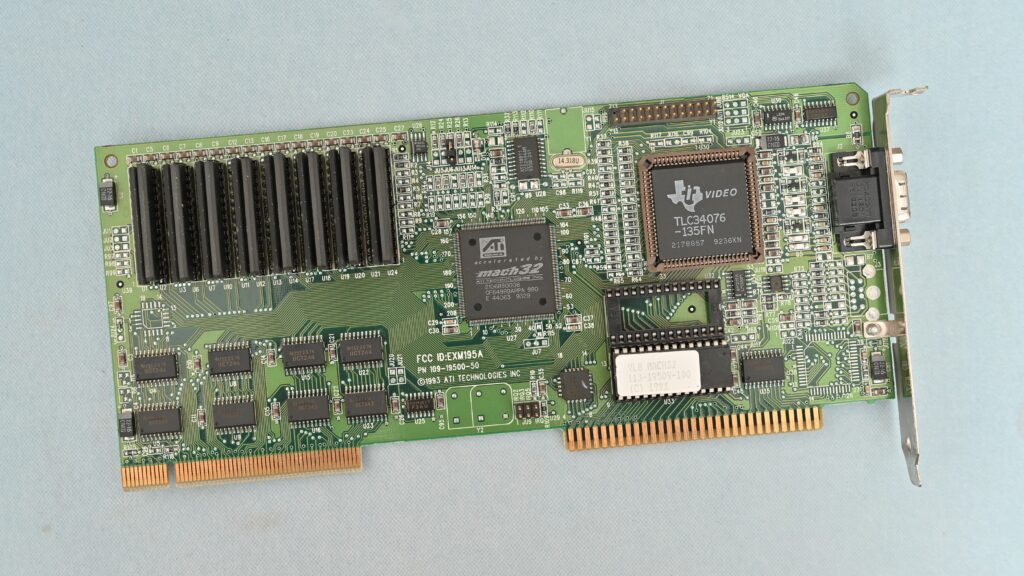
ATI Winturbo (ATi Mach64 VRAM)
The final ATI card is a way more advanced ATI Winturbo which features a newer 64-bit Mach64 chip. The chip is accompanied by 2MB of dual-ported VRAM. The VRAM is non-upgradeable on this particular card which is the only difference between this card and the high-end version marketed as Graphics Pro Turbo.
Although better than the ATI Graphics Wonder performance of these cards lags behind expectation in DOS and just average in Windows which is surprising given by 64-bit and VRAM combination. But it could be a driver issue.
What I liked is the output quality and also the default fonts in text modes gave it a unique look of the DOS prompt.
Trident TD4000SMT/V2 (Trident TGU9400CXi)
Trident cards had a very bad reputation for their performance back in the early ’90s. Trident ISA cards like 8900 or 9000 were dirt cheap, widespread and always considered as a basic option. When the VL-Bus era started, Trident scaled up their design for a faster bus and threw a bunch of mediocre cards to the market. The 94xx line consisting of entry-level TGUI9400CXi, mid-range TGU9420CRx and high-end TGU9440AGi is a revised generation that was designed for local-bus.
The TGUI9400CXi card in the test is a basic 1MB DRAM chip, 80 MHz RAMDAC. The chip has only limited acceleration capabilities. Many modes are not accelerated at all and the manual even recommends using standard Windows VGA drivers.
The card showed poor DOS performance trailing the group of all tests (only beating the ISA based Diamond Viper VLB).
Despite all trying, I was unable to run this card reliably in Windows 3.1 and thus windows test are missing, but if they were included I’d expect them to be rather poor.
Trident TGU9440AGi
The second Trident card in this test is model “7343” from an unidentified vendor. It comes with 2 MB of DRAM and upgraded 108 MHz integrated RAMDAC.
The TGU9440AGi chip offers comprehensive acceleration features including drawing primitives acceleration, advanced BitBlt unit, EDO DRAM support and more.
DOS results of these cards are not that bad. It offers essentially the same performance as top cards with much more advanced features. Sadly I was unable to obtain Windows results due to driver issues. But I keep trying.
I was quite pleased with the TGU9440AGi results. Arguably the TGUI9440AGi is the first “good” Trident chipset to consider.
DEC PCXAG-AN (S3 Vision 864)
This somewhat different card uses S3 Vision 864 chip. A unique feature of this card is that can be upgraded to 4 MB. Not many VL-Bus cards can be upgraded that high and especially not those with DRAM. Whether the upgrade is useful on this particular card is questionable. The card has a relatively modest 130 MHz AT&T DAC chip. Due to using a single-ported DRAM design, the card would struggle for RAM bandwidth at high-resolution modes the card is capable of.
It is not without interest that the graphics core in S3 Trio64 is derived from S3 864. Thus I’d expect very similar performance as the Diamond Stealth 64 DRAM T card. And results prove that. DOS results are almost identical. In Windows, the DEC card is a little slower. Presumably, drivers or a different memory clock plays a role. However, still has decent performance and third spot in the Windows test.
WDC Paradise Bali 32 (ARK1000PV)
The ARK1000PV is a 32bit late VL-Bus/PCI chipset. It has memory-mapped acceleration roughly matching the GD-5429 feature set, including the memory-mapped BitBlt unit. The manufacturer datasheet advertises generous buffering allowing zero-waitstate operation at VL-Bus 50 MHz speed which is a promise of solid DOS performance. The flexible memory interface allows for a fast memory bus up to 80 MHz, however, the card that was tested was equipped with only 70ns RAMs and a somewhat reduced clock. Unlike other budget VGA chips of the era, the RAMDAC isn’t integrated into the chip so the card uses an external ARK 1491 part.
This modest-looking card came as a complete surprise. It decisively won tests in DOS. Clearly, the chip is well optimised for VGA transfers. Sadly accelerated Windows performance does not follow the suit and the performance was below average. Especially in high-resolution modes, it can’t hold the pace with cards using a wider memory bus or VRAM chips.
Still, if looking for the absolutely fastest VL-Bus card for DOS this might be it.
Avance Logic ALG2228.A
The manufacturer of this ALG2228.A based card couldn’t be precisely identified. However, the FCC ID refers to Advance Logic, Inc so this card might be a generic reference design. A major German vendor Spea sold an almost identical card under V7 Vega Plus branding. A little could be found about the chip and its capabilities. However, it is clearly a low-end 32bit design with some basic GUI acceleration capabilities.
The card combined with 1MB DRAM offers unpopulated memory positions for alternative memory configurations up to 2MB DRAM. It showed mediocre performance in DOS and a rather disappointing showing in Windows, especially at high resolutions.
This was a budget card back in its days and doesn’t shine today.
ExpertColor DSP6430 (Wingine GDX)
Somewhat less common video card uses the F64300 controller from Chips&Technologies also called Wingine GDX. This chip has a unique feature as in addition to 2MB DRAM it allows optionally to install extra up to 256k of RAM to facilitate some form of GUI caching acceleration mechanism. The idea is that this would allow the chip to process data even when Video RAM is saturated by RAMDAC access. The card in the test had all memory sockets populated. This gave card about 15% higher Windows scores with no impact on DOS performance.
The controller is fully 32bit and offers solid acceleration capabilities.
The card showed excellent DOS performance matching throughput of other high-end chips except for Bali32. The Windows performance was also very good – almost reaching or matching 64bit chips. Sadly, the drivers used for the test had some stability issues in 24bit modes.
Test Results
DOS
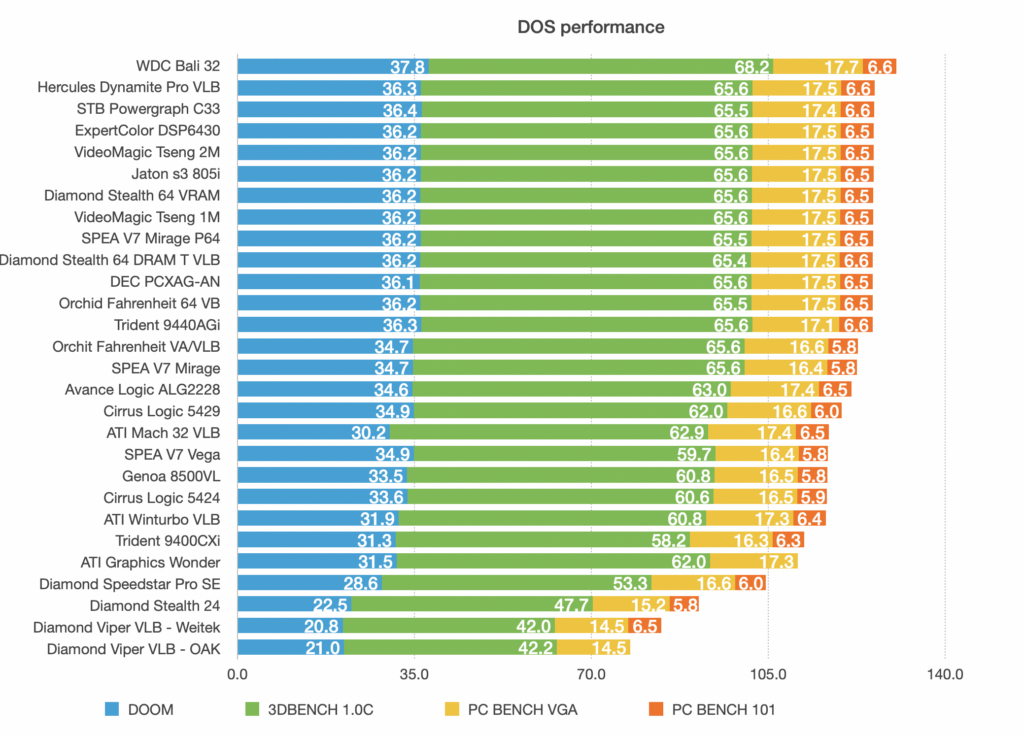
Windows 3.1
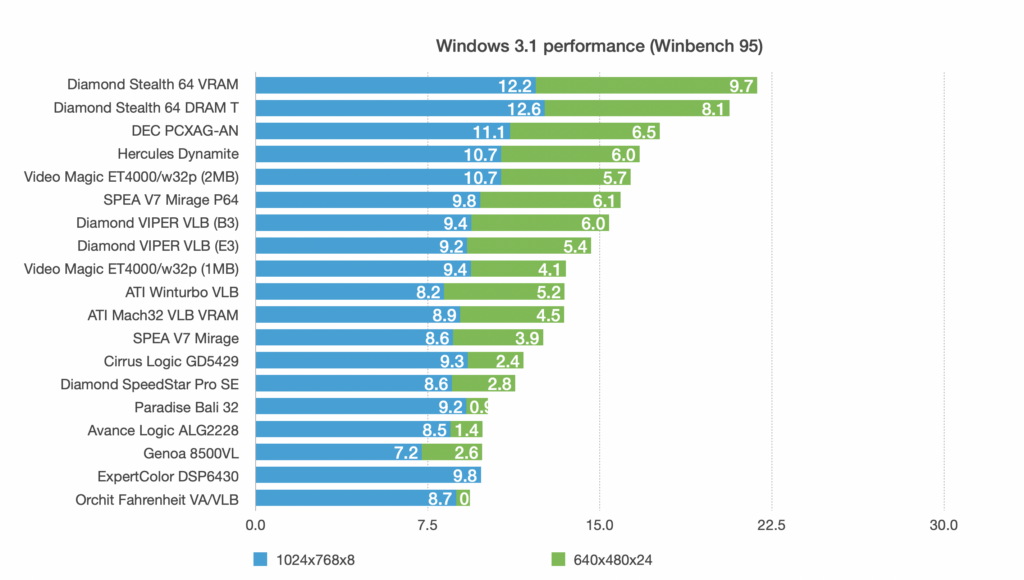
Test spec
All cards were tested on the NexGen NxVL motherboard with NexGen Nx586-P90 CPU and 32 MB RAM. VL-Bus is clocked at 41 MHz on this system.
All cards (but one) used 0 wait-state configurations where possible. No overclocking tools have been used.
Latest available vendor-supplied drivers used for Windows 3.11.
In DOS no extra tools were loaded unless required to complete the test.
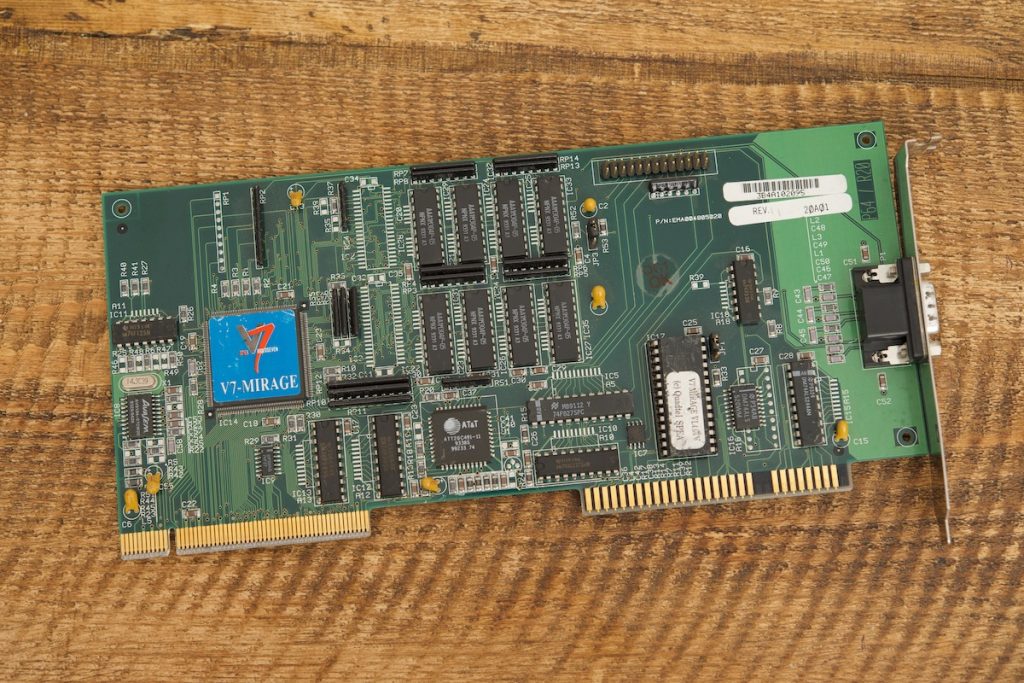











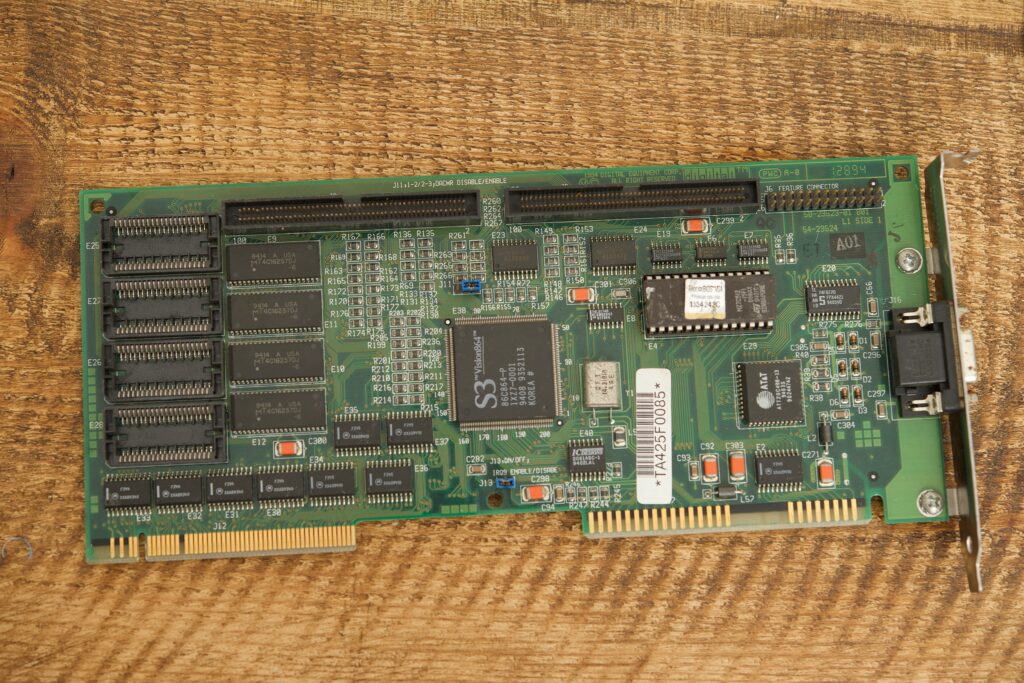



As said above there are no big differences in DOS, and these tests were made on a very fast system – relatively to a systems that were used in VLB heyday time.
When tested in a more typical DX2/66 system, values would be lower, and differences even smaller (~24,0 ± 1,0 FPS in Doom).
ISA cards were a real bottleneck though, as they delivered ~14,0 FPS in Doom (and that’s why everybody wanted a VLB card back then).
“The GD5422 is essentially a scaled-up version of the popular CL-GD5422 for ISA bus” probably a typo there, shouldn’t it be ” The GD5424 is essentially a scaled-up version of the popular CL-GD5422 for ISA bus”?
Also it says “legs” instead of “lags” somewhere else.
Great review! Missing a couple of Tridents (9400CXi aka “piece of crap”, 9440AGi, and plain 9440, in a slow-to-fast order). I’ve been doing something similar but on a DX2/66, and the difference is almmost neglible between the top performers. The crappy ones are always a step below.
Fixed. Thanks.
Tridents are coming!
Great article!
Nice work! I’ve had a bunch of different VLB cards in my stash, but never enough time to sort them all out and decide which ones to use, so this article helped me quite a bit.
what is the setting for zero waitstate operation on the STB Powergraph C33? i have the same card and would like to know how to configure it as such.
Hello, did you figure out which jumper is for 0 wait state? I have the same board and would like to know?
Great work!
As far I know the Weitek P9000 working is much more difficult than “VGA chip + GUI/accelerator chip” (like on Imagine 128; Voodoo Rush or lot 3Dlabs based cards) solutions. I have read somewhere that 5286 (and OTI087X) adds only that things which are missing in the P9000, but other parts of 5286 or OTI087X are not used. So both chips are works simultaneously in DOS (and GUI too). This is why P9000 cards have problems with Commander Keen games (DOS), although OAK chips have great DOS compatibility (this I have tested on Diamond VIPER VLB with OAK OTI087X BIOS version: 3.09).
Hello Mpe, please help me. My Avance Logic ALG2228.A VLB card is missing Bios. Is it possible to upload DUPM bios? Thanks.
Hi Tomas,
You can download bios from here:
http://www.vgamuseum.info/index.php/cpu/item/120-avance-logic-alg2228-a
Nice!
What is Your MB BIOS version?
Really great review that covers the full gamut of what was available back then. I don’t even think a magazine from that era would have been able to pull this off. Good work!
Hi MPE. Very nice job on testing all these cards. Any chance you can dump and share BIOS for SPEA V7 Mirage (S3 805-P)? Unfortunately I got mine without BIOS chip.